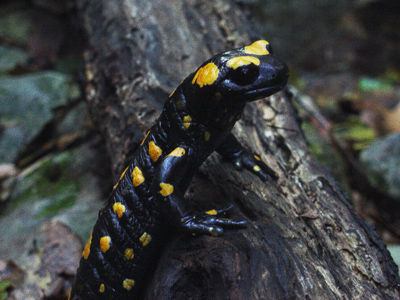HAIFA (Press Release)–Fast development is often perceived as an advantage, as it enables better harmony with one’s environment and readiness to cope with the challenges that it poses. However, research conducted at the University of Haifa, Israel, and University of California, Santa Cruz, and published in the scientific journal PLoS ONE*, found that the acceleration of developmental rate incurs potentially lethal physiological costs for the developing individual.
“Our findings are consistent with research findings on other animals and call for further research on rates of development in humans,” said Asaf Sadeh who led the study.
This study, part of Sadeh’s PhD research, was conducted on the fire salamander (Salamandra infraimmaculata) in conjunction with Prof. Leon Blaustein and Noa Truskanov from the University of Haifa, and with Prof. Marc Mangel from the University of California. The fire salamander in Israel breeds in temporary pools that fill during the winter rains and usually dry up in the spring. The larvae that are born into these pools must complete their development and metamorphose into terrestrial life before their pools dry. Larvae failing in this developmental race are destined to die from desiccation.
In the first part of the study, the scientists examined whether salamander larvae employ some early warning mechanism that alerts them to step up their rates of development to avoid drying. They reared an experimental group of larvae in water, to which they added a minute quantity of powder of ground larvae that had desiccated in natural temporary ponds. The development of these larvae was compared to a control group that was not exposed to the powder. They found that immediately after their birth into the pond, the larvae detected the presence of the dried remains and developed more quickly than the control group. Sadeh and colleagues propose that the chemical composition of the flesh of the dead larvae changes as they toast in the sun, producing a unique “scent of death”. These chemicals are released back into the water during the next rains, when the pond fills up again. This apparently provides information to the newborn larvae on the expected water-holding capacity of their pond, and signals them to set a high developmental rate to avoid a similar fate.
While chemicals from previously desiccated larvae can inform as to possible drying of pools in a relatively short time, reducing water levels can serve as a more reliable predictor of imminent pond drying and risk of desiccation. In the second part of the study, the researchers manipulated the water-levels for both groups, to simulate actual drying or non-drying conditions. They found that, after a while, the larvae will adjust their initial rates of development according to the actual water levels of their ponds.
However, they also found that accelerated development carries costs: larvae that developed more quickly suffered greater rates of mortality. Larvae that falsely perceived the pond environment as long-lasting, and thus started life with a slow developmental rate, but then realized their misperception and compensated with significant acceleration, suffered the greatest rates of mortality. The physiological mechanisms underlying these costs are unknown, but are thought to involve both cellular causes such as oxidative damage from increased metabolic rates, and tissue-level causes such as overexploitation of undifferentiated stem cells or disrupted balance between the differentiation and growth of different tissues in the body. These physiological costs may also lead to increased vulnerability to environmental stresses other than drying, such as heat, disease and parasites, and might result in death.
According to Sadeh, these results are consistent with those of recent studies on the costs of acceleration in growth following starvation in various other organisms, including insects, fish, amphibians and mammals. He suggests that this calls for further research on human development, such as motor, immune, sexual and cognitive development. “These new findings are thought-provoking when considered in relation to widespread perceptions of optimal child development. Boosting a certain aspect of a child’s development allows the child to cope better with the corresponding aspect of the environment, but may be traded off with some other aspect of development, potentially rendering the child less competent for other environmental challenges,” suggested Sadeh, but emphasized that the study of the costs of development rates is in its infancy, and that more work needs to be carried out before any applicable conclusions can be drawn for human development.
*
Preceding provided by University of Haifa
* Sadeh A, Truskanov N, Mangel M, Blaustein L (2011) Compensatory Development and Costs of Plasticity: Larval Responses to Desiccated Conspecifics. PLoS ONE 6(1): e15602.
